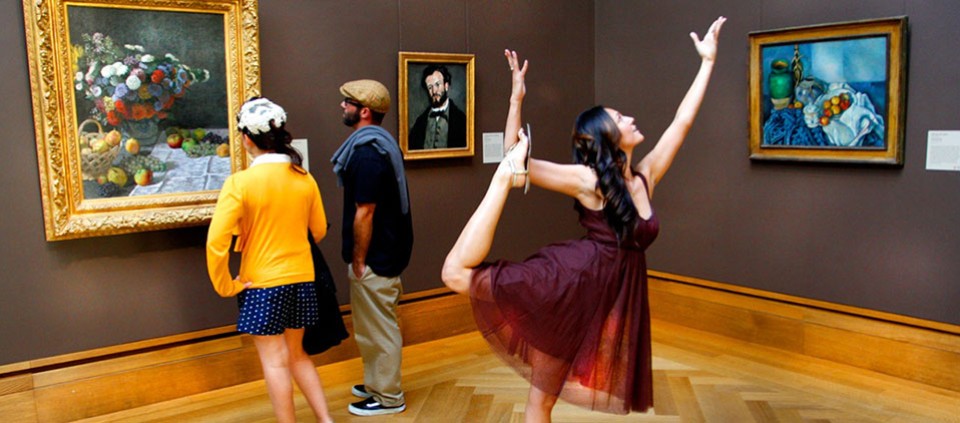Getting Lost in a Museum: The Power of Art to Spark the Senses and the Soul

Photo by Robert Sturman
In the summer of 2002, after living in New York City for almost a year, I went to the Metropolitan Museum of Art to fill my head with color. I had no idea what I’d find at the Met that day, but I craved time alone, among strangers. I hoped to put my worries on hold.
The main exhibit featured Paul Gauguin. The hall was crowded but a large map caught my eye, indicating Gauguin’s ports of call. “He went to all those places?” someone said over my shoulder. It was my thought, too.
Gauguin was a banker who quit his job to travel and paint. I’d quit my job on a cruise ship to find a 9-to-5 job in the city. But I couldn’t find work. At the Met, I wanted to make my own map, to pinpoint the places I’d seen before my unemployment.
If I allow myself, I can get lost in artwork—particularly when I’m feeling out of sorts—the lull and fascination of so much visual input, the stories told in other points of view. I can release my own stories for a while. As photographer and Kripalu presenter Robert Sturman says, “For me, the museum is the holiest of the holy human-made structures on our planet. Within those walls lives the history of our world, told by artists.”
It’s easy to feel overwhelmed by the breadth of art history. I asked artist and teacher Ann K. Lindsay for advice. What does she suggest for those who feel intimidated? “Truth be told, I always feel intimidated in renowned museums. Being a painter, this is more than a little embarrassing. Or shall we say, interesting? I have been to Paris eight times. I have yet to go into the Louvre. That should tell you something.”
For this reason, Ann recommends Old Masters Rock: How to Look at Art with Children by Maria-Christina Nottebohm. “Since I’m basically a child where all this is concerned, it’s great. And it does encourage the fact that your interpretation matters.”
I consulted Sarah Platt-Finger, co-presenter of Yoga and Creativity: Unlock Your Inner Artist. In this program, works of art from both the Rubin and MASS MoCA will be on display digitally throughout the yoga sessions. “I think it’s important to remain open and receptive when viewing artwork,” says Sarah. “Yoga helps us to be spontaneous, inspired, and in the moment. That is what we should bring with us when we’re taking in art: no preconceived notions, no expectations, and no projections. Simply take it all in through your senses and let it transport you.”
Sarah looks to the child’s perspective as well. She brings her seven-year-old daughter to museums. “I get to see the exhibits through her eyes. This keeps my perspective fresh and less cerebral.”
I tend to go to museums solo and have no set itinerary. In this way I have the “freedom to act a little weirdly,” as author Alain de Botton says in The Art of Travel. I don’t have to temper my pace or opinions. I only have to pay attention to my reactions.
Author and teacher Julia Cameron calls this kind of excursion an Artist Date, as explained in The Artist’s Way. “The Artist Date is assigned play, a once-weekly, festive, solo expedition to explore something that interests you. It need not be overtly ‘artistic’—think mischief more than mastery.”
A visit to a library or a bookstore would also constitute an Artist Date, but there I berate myself. (Why isn’t my book on the shelves?) I’m not a visual artist, and this is part of the appeal of museums. I’m a visual learner, according to the VAK model of learning. Visual learners need to see information to learn it.
Says Ann, “I have always been drawn to paintings that move my heart. If they didn’t, I just kept walking. But I’m excited about slowing down to learn about and look more deeply at paintings that may not move my heart but are still of great value and great soul. And I love the idea of this becoming a meditative practice.”
If I’m lucky, a museum will ignite an idea. In the Met, I became entranced, not necessarily by Gauguin’s artwork, but by his story—his arrogance, his addictions, his family, left behind. I carried around these whispers. Then I began to draft ideas that became a manuscript. Seventeen years after wandering into that exhibit, my novel, about a painter who travels, will see the light of day.
As Robert says, “Newspapers come and go. Magazines come and go.” (And books, perhaps.) The artists themselves may not always be saints, “but works of art have the potential to be preserved throughout the ages as items describing our world, celebrating our existence.”
The act of viewing artwork, for me, is a way to let distractions fall away. It’s the opposite of scrolling through an endless feed. It’s one thing at a time, which frees me from the pressure to overthink or multitask. Here’s something framed, under lights, asking for my focused attention.
Lara Tupper’s second novel, Off Island, inspired by the life of Paul Gauguin, will be released by Encircle Publications in January 2020. laratupper.com
Browse creative expression programs at Kripalu.
© Kripalu Center for Yoga & Health. All rights reserved. To request permission to reprint, please email editor@kripalu.org.
Lara Tupper, MFA, is the author of two novels, Off Island and A Thousand and One Nights, and Amphibians, a linked short story collection forthcoming in 2021.
Full Bio and Programs